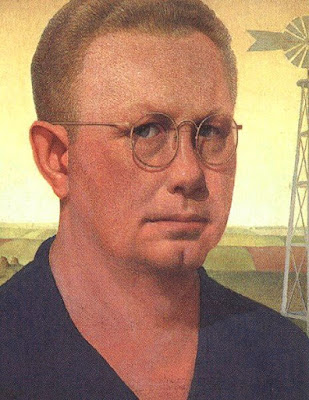Mr. Wood was born on a farm near Anamosa, a small town in northeast Iowa, and moved to Cedar Rapids as a child. He studied formally at the Minneapolis School of Design, the School of the Art Institute of Chicago, and subsequently spent substantial time in Europe during the 1920s, where he studied at the Academie Julien. Although he was influenced by the Impressionist and Post-impressionist movements, it was actually the Flemish painters--particularly van Eyck--that made the biggest impact. If you look at American Gothic, or others in his oeuvre, the influence of the smooth flawless surfaces of the Flemish painters is clear.
 |
| Grant Wood, "Self Portrait," 1932 |
As it happens a friend of mine (who like Mr. Wood, is from near Anamosa) seems to confirm his being a pariah during his lifetime. According to her, only three people were present at his graveside funeral service: the mortician, the minister, and the gravedigger. She believes the lack of mourners was clearly because of his homosexuality. Nan, his sister and heir (and the woman in American Gothic) was not there, nor was anyone else from the family, from Cedar Rapids, nor from the University of Iowa where he taught, nor from Anamosa. (The gravedigger was my friend's grandfather.)
 |
| Grant Wood, "Returned from Bohemia," 1935 |
Given his closeted position, his "Returned from Bohemia," which includes a self portrait, painted in 1935 after he had joined the faculty of the University of Iowa has particular power. In small towns everywhere, it often feels as if everyone is looking over your shoulder, judging and condemning or admiring. For someone with a secret life and accustomed to a freer society, the Midwest must have been hellish at times.
 |
| Grant Wood "Family Doctor," lithograph, 1940 |
If you want to explore Grant Wood's works in more depth, the Figge Museum in Davenport is a good place to begin.
No comments:
Post a Comment